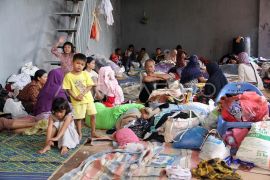At least 15 lakes in Indonesia are in deplorable conditions that urgently need to be addressed.
"Therefore, we need to seriously handle and rehabilitate these lakes which are now in an advanced stage of degradation. Efforts to save these lakes have to receive top priority so that water supply for the people around the lakes will not decline," Environment Minister Gusti Muhammad Hatta on Friday.
He admitted that a total of 15 lakes in different parts of Indonesia were now in critical conditions and in urgent need of rehabilitation.
"The lakes are located in various parts of the country such as Lake Rawa Pening in Central Java and Lake Toba in North Sumatra," the minister said after opening the second National Conference on Indonesian Lakes (KNDI) here on Friday.
He said that indicators of critical lakes included the silting of the lake bed due to soil erosion and the growing of various plants such as water hyacinth that caused the drop of the lake`s water.
On the measures to be taken safeguarding the critical lakes, the minister explained that the government will give priority to the rehabilitation and the restoration 15 lakes. The 15 lakes` conditions were very critical.
"The budget for lake rehabilitation will be taken from the office of the environment minister. Other ministries like the ministry of public works will also provide assistance," Gusti Muhammad Hatta said
The efforts to restore the lakes` healthy conditions would be made through a short and long term scheme. In the short term, the lakes for example would be cleaned from water hyacinth plants because the trash from hyacinth was big and could affect the water of the lake.
He said that the handling of Central Java`s Lake Rawa Pening whose condition was very critical would be prioritized and be done immediately, of course with the assistance of the local government.
"We hope that the people and the local governments would also involve in the lake safeguarding drive because it will be difficult if the efforts are only made by the central government," the minister said.
He said that besides the 15 very critical lakes, there were still 840 others whose conditions were also critical, yet they were not as worse as those of the 15 lakes.
In Jakarta .for example, there are at least 200 dams that need rehabilitation. In West Java`s Jatiluhur district, the water level of Lake Jatiluhur had dropped causing fish to die en masse.
"The death of fishes in Jaluhur was due to oxygen shortage following a drop in the water level of the reservoir," Komaran, head of fishery and animal husbandry service of the Purwakarta, said here on Friday.
The fish deaths occurred in a number of sections of the lake such as in Blok Cibinong, Kaleosan and Pasirjangkung. "Golden fishes which were ready to be harvested died in the shallow sections of the Lake due to drought," he said.
"The fishes are sick in the first place and then they die due to lack of oxygen," Danu, a fish breeder, said. Komaran said the mass fish deaths occurred in several parts of the Lake whose depth was not enough for fish, due to depreciation of the water volume of the lake.
Reverse currents in Lake Jatiluhur often caused the death of thousands of tons of fish which happened at the peak of the rainy season at the end of the beginning of the year. This could happen because the lake already in bad condition.
In Jakarta and environs at least 200 dams were also in degraded conditions.
Some time ago, the Environmental forum ,Walhi, suggested that government should renovate at least 200 dams in Jakarta and surrounding areas so that they would ba able to contain excess water from heavy rains in upstream areas.
"This revitalization program needs to be coordinated immediately between the National Development Planning Board (Bappenas) and the Ministry of Public Works as well as with the regional governments of Jakarta, Bogor, Tangerang and Bekasi areas (Jabodetabek)," Erwin Rustam of Walhi said.
He said the program should be carried out immediately, particularly for dams whose downstream areas were residential regions. The other solution that could be pursued r to overcome possible natural disasters was to stop the conversion of river basin (DAS) and water catchment areas into land for development projects or other purposes.
The change in the function of water catchment areas had caused the decline in the number of reservoirs in the Jabodetabek region. According to Walhi, at least 56 lakes had disappeared due to failure to conserve them.
"The number of dams in the Jabodetak area has declined from 240 in 2004 to 184 in 2009 while the government always claimed that there are over 200 lakes at present," Erwin Rustam said.
Of the 184 dams, 19 are still in good condition while the remaining ones are now experiencing serious sedimentation and damage. In term of width, the 240 reservoirs in the Jabodetabek areas have also decreased from 2,337.10 hectares to 1,462 hectares (184 dams).
The average depth of the reservoirs also has dropped from the previous 5 to seven meters to less than 2.5 - 3 meters, including the Gintung dam in Jakarta outskirts in Cireundeu village, Ciputat sub-district, Tangerang. Three main factors have caused the disappearance of the lakes, namely the change in the function of land, the lakes being used as garbage dump sites and sedimentation.
The change in the function of land has caused the dam to be converted into resettlement, restaurant and business centers. "There are lakes in Jakarta and Depok which have become garbage dumping sites," Rustam said. (*)
Reporter: By Andi Abdussalam
Editor: Kunto Wibisono
Copyright © ANTARA 2011











